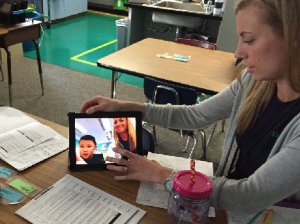Record Yourself to Improve Your Practice

I took a speech class one semester when I was in undergraduate school. For our first assignment we had to give a short speech that the teacher videotaped. Our extended assignment was to watch the recording and critique our performance. That proved to be a very eye-opening experience for me. If you had asked me how I did right after I gave my speech I would have told you I was pleased with my delivery. When I watched the recording, however, I realized I had said “um” consistently throughout. It became quite clear to me that when I was publicly speaking I was not completely aware of everything I was doing.
My next experience with videotaping myself came when I was working on my masters’ degree. The school where I did my student teaching was a considerable distance from my college, and it was not always possible for my advisor to make the drive to observe me. Her solution was to have me videotape my lessons. This proved to be a very insightful practice. I not only learned more about myself and how I taught, I also learned more about the students in the class.
These two experiences taught me the value of videotaping myself. Once I started teaching I made it a point to record myself at least once a year if not more. Here are some of the benefits that I have found can come from videotaping yourself in the classroom.
Who am I calling on?
During the lecture portion of my class time I tried to help keep my students engaged by moving around the room and calling on them to answer questions or respond to the comments of others. Although we may think we are being equitable in whom we call on, the video recording may reveal otherwise. Without realizing it we may be inadvertently calling on specific students more frequently than others. The video may also reveal that we tend to call on students seated on one side of the room more so that those seated on the other. Having an unbiased and unblinking eye in the back of the room to record our lecture time can help us ensure we are reaching all of our students.
Am I providing enough wait-time?
In my younger days I was a member of a rock band. When we were in the studio we would record our songs at a certain speed that was usually guided by a “click track”. One of the things we noticed whenever we watched recordings of our live performances was how much faster we played the songs when we were on stage. Much of that had to do with the excitement of playing live and the energy coming from the crowd. The same can be said for teaching. Sometimes we get caught up in what we are teaching, or we try to cover the material within a certain amount of time. This can cause us to move at a much faster pace than we may have intended. The result is that we may not be giving our students enough time to absorb what we are telling them, nor to answer our questions. Early research found that teachers typically provided .7 to 1.5 seconds of wait-time for students after asking them a question. For many students that is barely enough time to process the question, let alone formulate a thoughtful response. The research also found, however, that providing at least 3 seconds of wait-time tended to have a positive impact on both the students and the teachers. If you are not sure how much wait-time you are giving your students, the video camera can let you know.
Am I moving?
My first classroom was in a portable building that had a small window A/C unit. Unfortunately that air conditioner only cooled a portion of the room. I confess that during the hot months I tended to roam within that zone of conditioned air. Videotaping yourself may reveal that you tend to stay in a certain area of your room as well. Moving evenly throughout the classroom can help minimize discipline issues as well as maintain student engagement.
What are the students doing?
One of the things revealed by my student teaching videos was that a particular student could not remain seated for even a relatively brief period of time. My cooperating teacher was aware that this student was “busy”, but neither of us realized to what extent until we watched one of my taped sessions. The video allowed us to see just how much of an impact his inability to stay seated was having on his learning. This revelation allowed us to make more effective accommodations for both him and those around him.
Good teachers, just like good athletes, know there is always room to improve. Athletes watch videos of themselves in order to study their technique and execution. Teachers can benefit from the same practice. Give it a try. You never know what might be revealed by the camera’s eye.
This piece was originally submitted to our community forums by a reader. Due to audience interest, we’ve preserved it. The opinions expressed here are the writer’s own.